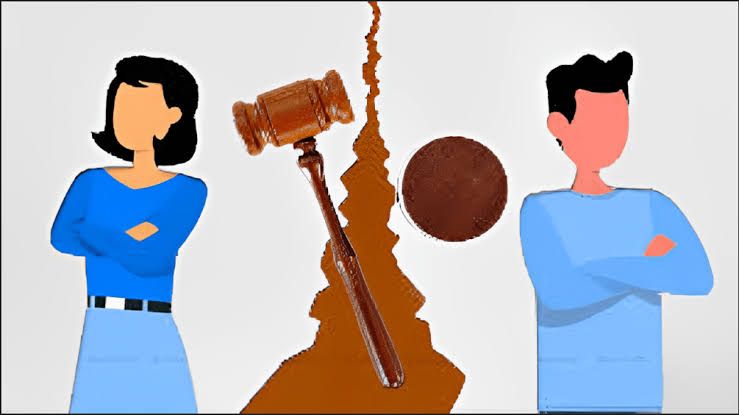Author: Ritika Dembla, a student at G.H. Raisoni Law University, Amravati.
ABSTRACT
“When two people decide to get a divorce, it isn’t a sign that they ‘don’t understand’ one another, but a sign that they have, at least, begun to.”-Helen Rowland.
The shifting societal attitudes towards divorce reflect a broader transformation in values and priorities. With women gaining financial independence and society placing greater emphasis on individual happiness and autonomy, divorce has become more accepted as a means of seeking fulfillment and escaping unhappy or abusive relationships. Legal systems have responded by streamlining divorce processes and promoting equitable distribution of assets, easing the financial burden on divorcing couples. However, despite these advancements, divorce remains a challenging and emotional process for those involved. As courts continue to grapple with the concept of irretrievable breakdown of marriage, it is evident that the evolution of divorce law mirrors the changing dynamics of modern relationships and societal norms. Ultimately, the recognition of irretrievable breakdown as a legitimate ground for divorce underscores the importance of prioritizing individual well-being and happiness in the pursuit of a fulfilling life.
INTRODUCTION
Hindu civilization places a great deal of importance on marriage, viewing it as a sacred union that serves as the cornerstone of a stable family and a society. Marriage is seen as an eternal and irreversible sacrament, deeply rooted in religious traditions and cultural norms. Marriage has always been recognized in Hindu law as a sacrament (samskara), rather than a mere civil contract. It is considered as a lifetime commitment between spouses, representing the union of two souls on a spiritual journey guided by dharma (righteous duty), artha (prosperity), kama (desire), and moksha (liberation). The concept of ‘saptapadi’, in which the couple takes seven steps together, indicating a promise and dedication to various aspects of married life, is central to Hindu marriage. However, divorce is also a concept that exists within the Hindu law.
Divorce has traditionally been governed by specific grounds outlined in the Hindu Marriage Act, 1955. Dissolution of marriage is a complex and deeply personal matter that overlaps with a number of legal, social, and cultural factors. In the past, divorce was rare and only permitted in exceptional circumstances, often to protect mistreated women. But opinions have shifted, and divorce laws have become more flexible over time. The Hindu Marriage Act of 1955 made substantial changes by permitting divorce on various grounds. Divorce was initially granted based on one party’s faults, but later, amendments established the concept of mutual consent and recognized irretrievable breakdown of marriage. This means, that if a marriage is completely broken, emotionally dead, and beyond repair, divorce may be granted. However, the evolving landscape of familial relationships and societal norms has generated debate over the identification of “irretrievable breakdown of marriage” as a separate and distinct ground of divorce.
HISTORY OF IRRETRIEVABLE BREAKDOWN AS A GROUND FOR DIVORCE
The concept of irretrievable breakdown of marriage originated in New Zealand, where it was recognized that one spouse’s fault or wrongdoing should not be the sole reason for ending a marriage. Therefore, the law needed to accommodate this recognition in order to fulfil the requirement for spouses to have the choice to end a marriage without having to prove wrongdoing.
In England, the case of Masarati v. Masarati marked a pivotal moment that paved the way for the recognition of the theory of irretrievable breakdown of marriage. The Court of Appeal acknowledged a shifting perspective, emphasizing the significance of considering the breakdown of marriage as a key factor. Similarly, the House of Lords decision in Blunt v. Blunt in 1943 further solidified the acceptance that there was no public benefit in maintaining the legal existence of a marriage that had effectively ceased to exist.
The Law Commission of England, in a report, outlined two primary objectives for good divorce laws:
- To strengthen the stability of the marriage wherever possible.
- In circumstances where a marriage has permanently broken down, to assist its divorce in a fair and compassionate manner, minimizing bitterness, humiliation, and misery.
The underlying idea is to recognize that, while marriage is based on companionship and love, individuals should also have the option to end the union with dignity and ease, without having to prove fault in court.
In India, two prevailing theories in divorce law are the Fault Theory and the Mutual Consent Theory. While these meet the expectations of many couples seeking divorce, there is still a need for provisions that address the possibility of serious emotional harm to the marriage, yet couples may not wish to disclose intimate details to the public or legal system. Such provisions should allow spouses to dissolve their marriage without having to go through lengthy legal procedures or seek approval from higher courts, as has been the case with dissolution on grounds of irretrievable breakdown.
71ST LAW COMMISSION REPORT
In its seventy-first report, the Law Commission of India proposed introducing irretrievable breakdown of marriage as a ground for divorce. The report stated that restricting divorce to particular offences or marital problems may result in injustice in cases where neither partner is at fault or the marriage is unworkable due to circumstances beyond their control. In 1981, a bill was introduced proposing irretrievable breakdown of marriage as a ground of divorce, but it was opposed by groups concerned about husbands deserting their wives.
217TH LAW COMMISSION REPORT
In 2009 once again, the Law Commission of India recommended including irretrievable breakdown of marriage as a ground for divorce in its 217th Report. Bills such as the Marriage Laws (Amendment) Bill 2010 and the Marriage Laws (Amendment) Bill 2013 were introduced in response to these proposals. However, as of now, the law does not recognize simple marriage breakdown as a divorce ground under any personal laws in India. Despite numerous cases in which marriages have completely broken down, courts have been restricted by legal technicalities, rendering them unable to grant effective relief. Nonetheless, legislative and judicial trends show a shift towards recognizing irretrievable break down as a separate ground for divorce.
FACTORS TO CONSIDER FOR DIVORCE UNDER IRRETRIEVABLE BREAKDOWN OF MARRIAGE
The court outlined several factors to assess irretrievable breakdown of marriage:
1. Duration of cohabitation post-marriage.
2. When the parties had last cohabited.
3. Nature of allegations leveled by each party and their families
4. Previous legal rulings and their influence on personal relations.
5. Attempts made for dispute resolution via court intervention or mediation.
6. Duration of separation (ideally 6 years or more).
Additionally, economic and social status, educational qualifications, presence of children, and alimony are vital considerations before granting divorce.
The court emphasized that prolonged separation with mutual agreement indicates a conscious decision, warranting timely divorce without unnecessary delay.
In ensuring fairness, the court stressed on balancing opposing party’s circumstances before granting divorce, guided by principles of equity.
CURRENT STATUS
The existing state of irretrievable breakdown of marriage in India indicates an inconsistency between legislative recommendations and judicial action. Although the Law Commission has urged for its inclusion as a divorce ground in reports such as the 71st and 217th reports, legal amendments have yet to be implemented. However, the Supreme Court has used its inherent powers under Article 142 of the Constitution to dissolve marriages on the ground of irretrievable break down. For instance, in the case of R. Srinivas Kumar v. R. Shametha, the Court dissolved a marriage that had irretrievably broken down after two decades of legal battles. While the notion of irretrievable breakdown of marriage has not been legally introduced into Indian law, the judiciary’s actions indicate an awareness of its importance. Nonetheless, any future incorporation of this ground for divorce should be accompanied by safeguards and exercised with discretion to ensure fairness and justice.
JUDICIAL PRECEDENTS
In Tapan Kumar Chakraborty v. Jyotsna Chakraborty (1996), the Calcutta High Court held that the Magistrate does not have the authority to grant divorce solely on the basis of irretrievable breakdown of marriage, as it has not been established as a legal ground for divorce.
Divorce based on irretrievable breakdown of marriage can only be granted by the Supreme Court of India under Article 142 of the Constitution. This provision allows the Court to ensure complete justice in any case. This principle was established in the cases of Anil Kumar Jain v. Maya Jain (2009) and Manish Goel v. Rohini Goel (2010). No other court in India has the authority to grant divorce on this ground. While Section 13(1A) of the Hindu Marriage Act, 1955, added in 1964, is considered a step towards recognizing irretrievable breakdown of marriage, it is not officially recognized as a ground for divorce.
In numerous instances, the Supreme Court has declined to grant divorce based on Irretrievable Breakdown of Marriage, as seen in the case of Savithri Pandey v. Prem Chand Pandey (2002), where it found no grounds for invoking Article 142 of the Indian Constitution. On the other hand, the Court has granted divorce on this ground in cases like Samar Ghose v. Jaya Ghose (2007), where it acknowledged the prolonged separation and emotional disconnect between the parties, leading to an irretrievably broken marriage.
In the landmark case of Naveen Kohli vs. Neelu Kohli (2006), the Supreme Court upheld the Family Court’s findings that the Appellant had suffered psychological, physical, and financial abuse from the Respondent, resulting in an irreversibly broken marriage. This decision recognized irretrievable breakdown of marriage as a valid ground for divorce and requested the Legislature to alter the Hindu Marriage Act of 1955 accordingly. Prior to this verdict, divorce grounds in India were restricted to those outlined in the Act.
Subsequently, in the case of K. Srinivas Rao vs. D.A. Deepa in 2013, the Supreme Court affirmed that the concept of Irretrievable Breakdown of Marriage can be applied in cases where the parties have lived separately for an extended period, leading to an irretrievably broken marriage.
Courts have shown flexibility in handling divorce cases over time, working to keep marriages intact before granting a divorce without the consent of both parties. In circumstances where reconciliation efforts fail, divorce is granted.
In a recent judgment of Shilpa Sailesh vs. Varun Sreenivasan, the Supreme Court addressed whether it could exercise its powers under Article 142(1) of the Constitution of India when the procedure prescribed under Section 13-B of the Hindu Marriage Act, 1955 is in place, and whether it could grant divorce despite one spouse opposing the petition due to complete and irretrievable breakdown of the marriage.
CRITICISM
In the case of Vishnu Dutt Sharma v. Manju Sharma, Justice Markandey Katju expressed concerns about granting divorce on the basis of irretrievable breakdown of marriage, contending that courts are effectively legislating by creating grounds that are not specified in the legislation. However, the Neelu Kohli judgement, delivered by a larger bench, maintains the validity of considering irretrievable breakdown of marriage as a ground for divorce.
The Ministry of Education, Government of India, Department of Social Welfare, holds the view that existing laws, such as the Hindu Marriage Act and the Marriage Laws Amendment Act, provide sufficient grounds for seeking divorce, including irretrievable breakdown of marriage.
Additionally, the Indian Judicial System tends to prioritize the preservation of marriage, especially for the sake of children. Some argue that divorcing parents, regardless of the grounds, may not be in the best interests of the children, while others contend that ending an unhappy marriage could benefit the children.
CONCLUSION
Marriage is a sacred bond between two individuals, meant to bring happiness and fulfillment. However, when this essence fades, divorce becomes a viable option for couples to pursue happiness. Society now accepts divorce as a means to end an unhappy marriage, recognizing that it’s better to part ways than to endure misery together. The concept of irretrievable breakdown of marriage has gained legal recognition, allowing couples to divorce when their relationship is beyond repair, even if there’s no specific fault on either side. The Supreme Court of India has granted divorce in such cases, utilizing its power under Article 142 of the Constitution to ensure justice. While different religious laws address divorce, they all emphasize the sanctity of marriage and only permit divorce when the relationship is irretrievably broken.





